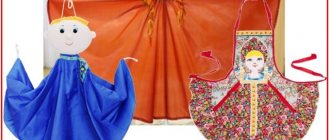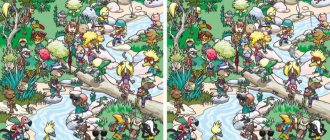THE ROLE OF SUBSTITUTE OBJECTS IN THE GAME ACTIVITY OF YOUNGER PRESCHOOL CHILDREN
So, E.E. Kravtsova states that “game is a certain attitude of the world to the child and the child to the world, the child to the adult and the adult to the child, the child to the peer and the peer to him” [5, p. 68]. Gaming activity, in contrast to play, is “a narrower concept; it presupposes special actions of children to model the world” [10, p. 201]. According to D.B. Elkonin, gaming activity includes “stages of its development: need, motive, goal, structure, “stating moments.” The latter, in turn, include an imaginary situation, a game role and the rules of the game” [10, p. 225]. As a rule, the concept of “game activity” is interpreted as a type of activity in situations aimed at recreating and assimilating social experience, in which self-government of behavior is formed and improved [6, p. 5].
Game activity is closely related to objective activity. In the monograph “Psychology of Game” D.B. Elkonin cites data from an experimental psychological and pedagogical study by F.I. Fradkina, confirming the fact that “all the main prerequisites for play arise during the development of the child’s objective activity under the guidance of adults and in joint activities with them” [10, p. 197].
As a result of mastering object actions, a child, under the guidance of an adult, learns the general scheme of action with an object related to its social purpose. According to the results of research by N.Ya. Mikhailenko, F.I. Fradkina, L.S. Slavina, “the path of game development goes from a specific objective action to a generalized game action and from it to a role-playing game action: eating with a spoon; feed with a spoon; feed a doll with a spoon; feeding a doll with a spoon, like a mother, is a schematic way to role-play” [10, p. 218].
Game activity is impossible without a game plan, role-playing actions, and game props. The most important condition for the success of gaming activity is the child’s emotional involvement in the game, awareness of its subjective emotional and entertainment significance. In the article “The Role of Play in Preschool Age” S.O. Kozhakina characterizes the types of story games:
- a game associated with a conditional (game) action in an imaginary situation;
- role-playing game itself (when the child directly takes on a play role around which an imaginary situation is built);
- director's play (when the child is the director, and the toys are actors) [4, p. 24-25].
A mandatory attribute of any game action is a toy. Play equipment allows the child to model an imaginary reality, based on the experience of objective activities and the experience of social interaction with others. The quantity and quality of gaming equipment determine the nature of the game (individual or collective), the form of the game, and the number of participants involved. A toy with a strictly fixed functional purpose establishes a certain set of role-playing actions with the object. The use of such a toy, as a rule, is limited to individual use and deprives potential participants in the game of the opportunity to “attribute” various properties to the game item, determined by the plot content of the game. According to teachers and psychologists, in particular O.A. Stepanova, M.E. Weiner, N.Ya. It is important to note that children’s games should contain “multifunctional play material, i.e. objects that do not have a strict functional purpose (sticks, cubes, etc.), since the finished toy largely inhibits the manifestation of children’s imagination” [9, p. 22].
Story play toys
Play is the most natural activity of a child. From an early age, playing becomes his favorite activity.
Purpose of the game: to develop the gaming experience of each child; help children master the world around them; encourage children to show their first creative expressions; to cultivate in the child a desire for playful communication with peers.
Much attention has been paid to toys and children's play activities since ancient times.
Toys were made from any available materials: first from bone, wood, plant clay, later from fabric, glass, leather and iron. In addition to serving playful functions, toys have been associated with various forms of religions as amulets and also as part of various rituals.
Since ancient times, rattles, rattles, animal figurines (cows, dogs, cats, etc., dolls, balls, tops) have been known. In ancient Egypt, for the first time, toys with a simple movement mechanism such as “Crocodile”, “Tiger”, “Text Kneader” were encountered. Popular toys of that time, especially in Ancient Greece, were horse figurines. In archaeological excavations, horses are also found - gurneys made in the 5th century. BC e.
According to the Greek philosopher Plutarch, among the toys of those times there were toys with clockwork mechanization, which indicates the high professionalism of the craftsmen.
It is also known about differences in the choice of toys among children of different sexes. The boys played with wooden balls, shields and horses. Girls preferred dolls. The complexity of making dolls varied - from a simple block of wood without arms, without legs, to dolls with shoulder, elbow and knee joints, a hairstyle and a complexly carved torso. Since those times, puppets have also existed. During excavations, miniature sets of dishes were often found, which were probably intended for playing with dolls.
Dolls were also traditional in Russian families. Moreover, both girls and boys played with rag dolls until they were 7–8 years old, and only then their games began to be strictly separated.
Games and toys, having undergone a number of changes, have remained popular today, influencing children's development.
In modern kindergartens and schools, play acts as a means of acquiring new skills, ideas, and developing useful skills.
As the child grows up, the game changes and becomes more complex. From birth to 2–3 years, games and manipulations predominate. In them, children perform various actions with objects and toys - manipulations, for example, touching, moving, swinging, shaking, throwing objects, knocking with them.
In the play set for children of this age, there should be balls, pyramids, leaves of different sizes nested into each other, multi-colored cubes of different sizes, multi-colored cubes, a spinning top, and tumbler toys.
Such toys develop the child’s motor skills and thinking. Toys should be bright and of different shapes. It’s good if the play set contains toys that make sounds (rattles, bells, bells, pipes, toys representing a piano, balalaikas, etc.)
By the end of the third year, children develop role-playing (creative) play. The first such games are simple plot chains of 2-3 actions that are repeated many times (for example, a boy rolls a car, a girl washes a doll). In play situations, children 2–4 years old treat, feed, put dolls and animals to sleep, prepare food, and travel by transport. For children 4–5 years old, games such as “Shop”, “Hospital”, “Pharmacy”, “Construction site”, etc. are typical.
An important role in the development of play belongs to plot-shaped toys, which are, as it were, auxiliary and at the same time necessary means of representation. Children willingly join the game if, along with substitute objects, it is possible to use real objects: umbrellas, bags, clothes, dishes, symbols. Thus, store departments can be marked with appropriate signs (fruits, vegetables, clothes, etc.); theatrical costumes are also used as visual means.
To carry out role-playing games, children need the following set of toys.
1. Doll family: dolls of different genders and ages. Both girls and boys need dolls; by playing and identifying with them, the child learns the world of human relationships and ideas, builds and creates himself. Through such games, children learn to behave correctly in certain situations, they form behavioral matrices necessary for proper socialization and adaptation in society. It is important to encourage such games, play with children, conduct dialogue on behalf of toys, creating different situations.
2. Doll accessories: doll clothes for the season, house, furniture, dishes, cash register, scales, medical and hairdressing supplies, watches, washing machines, stoves, TVs, crayons and boards, abacus, construction tools, telephones, etc. Various Fasteners, zippers, and buttons help develop fine motor skills. It must be remembered that a large number of overly detailed toys does not leave room for children's ideas, creation of what is missing and development of imagination.
3. Figures of animals (domestic and wild) cat, dog, wolf, fox, bunny, horse, bear, etc. It is desirable that they correspond in size to each other and to the human characters. To form a correct picture of the world in a child, it is important that the figures of animals reflect their real appearance, and not a humanized one (on the hind legs, in pants and shirts), humorous and humanized images are understood later.
4. Vehicles - cars, planes, trains, boats, helicopters, buses, etc. An important point when choosing these toys is the ability to place a driver, passengers, and building materials in them. And the ability to construct one from an ordinary car that meets the game’s concept develops mental flexibility, creativity, motor skills, and imaginative thinking.
5. Materials for various structures (slide, houses, cars, ships, hospitals, etc.) - tables, chairs, boards, blankets and pillows. Large-block wooden construction sets are well suited for such construction. The construction of such structures allows the formation of gross and fine motor skills, spatial concepts and volitional qualities of the child.
6. Available materials (rags, pebbles, twigs, pine cones, acorns), which, with the help of children's imagination, can be transformed into any materials necessary for play.
Theatrical and finger games will help the child understand and experience literary works, develop speech, fine motor skills and children's creative abilities. For such games, sets of plot figurines for acting out scenes based on fairy tales, theater characters, puppets, puppets for finger games, costumes, scenery elements, masks, etc. are suitable.
A special group includes homemade toys that stimulate the development of creativity and develop the ability to realize a plan. Creating such toys provides an opportunity for self-expression and helps increase self-esteem in a child.
In older preschool age, interest in toys is shown - fun that develops a sense of humor and curiosity, and evokes positive emotions in children. They encourage children to study their structure and principles of operation.
Barbie dolls should be used with great care. A doll at this age should focus the child’s attention not on beauty, but primarily on feelings of care. In their relationship to dolls, girls should feel like mothers and adults. Dolls are necessary in order to feed them, treat them, dress them, wash them, etc. Through Barbie, a lifestyle associated with endless outfits and entertainment is transmitted. It is also known that Barbie’s proportions cause persistent dissatisfaction with their figure in girls - an inferiority complex leading to nervousness.
Children's games with weapons (soldiers, guns, machine guns, pistols, tanks, swords, etc.) contribute to the release of internal aggression hidden in every person. If it spills out through “war games,” then in real life the child becomes calmer and more balanced. However, such games must be accompanied by comments from adults and have a certain plot.
Technically equipped, electronic and interactive toys that move, speak and sing themselves serve more for entertainment than for development.
Toys should not be working copies of adult objects in order to hone some useful skills from adult life. Therefore, he needs specific objects only as attributes that help him enter the role. In this case, object symbols are best suited. In the hands of a child, any stick can become a train ticket, a spoon, or a saber. This is where the child’s imagination and free creativity are manifested.
Variety is important for a child, not the number of toys. In order for toys to serve as a tool for a child’s development, it is necessary to teach children to play with them. And the active participation of parents in games with children generally has a beneficial effect on family relationships and child development.
Literature:
1. Journal of Modern Preschool Education No. 1, 2010
2. Journal of Modern Preschool Education No. 8 (50), 2014
3. Modern preschool education.
4. Modern preschool education No. 4 (30), 2012
5. Subject-spatial developmental environment in kindergarten, compiled by N. V. Nishchevo.
6. Educational area. Socialization. A game. O. V. Akulova, O. V. Solntseva.
7. Role-playing games for children, Edition No. 7, N. V. Krasnoshchekova.
8. Modern preschool education theory and practice, 6 (48), 2014.
9. Journal of Modern Preschool Education Theory and Practice, 3 (45), 2014.





